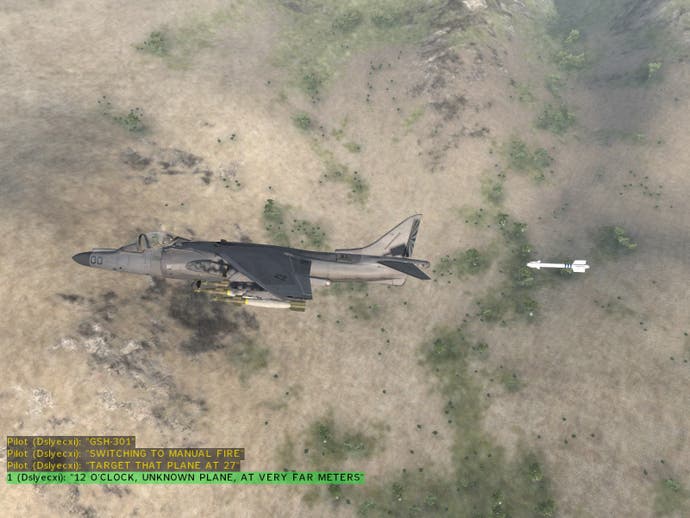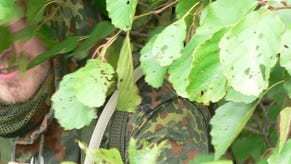Bombarding Bohemia
As in, Interactive. As in, with Armed Assault questions.
When publisher Codemasters and developer Bohemia Interactive split, BI got the Le Creuset saucepans, the ride-on mower, the foot spa and the dog, but not the right to use the name of their stalwart soldier sim Operation Flashpoint in future games. Unperturbed, the studio has gone and made a sequel anyway.
Due out in the UK on the 16th of February, Armed Assault (ArmA) will come with a seamless 400 square-kilometre battlefield (the extraordinary island of Sahrani) an array of weapons and vehicles that would shame the Imperial War Museum, and the kind of realism that persuaded the American, Australian and Israeli armies to invest in VBS1 (an earlier OFP offshoot).
To help pass the time until the review arrives, we put a few questions to Bohemia Interactive CEO Marek Spanel.
Marek Spanel: There's a ruined house west from Estrella on the western coast of South Sahrani on a really nice place above the sea. This one I would really like to renovate and build there a nice holiday home for my family. I like the village and the surrounding area and our kids would love the beaches and nature. Estrella is also not very busy town but still with few places to buy food or go for dinner and nice nature all around the place, exactly the way I like it.

Yes, they do. Most notable is probably simulation of light and human eye dilatation. That means fighting towards low sun is a real disadvantage, while entering dark or light areas can distract your view for some time. Even more subtle things, like vegetation moving in wind or some insects and birds around, can make difference as no longer anything that moves is your enemy.
There's a tactical implication in the fact a building can be destroyed by a tank or satchel, which is also quite significant. But most important is probably the fact that density of objects in the environment has grown vastly over OFP, which gives you much more options to behave tactically and gives you more cover.
ArmA's ballistics simulation now includes material penetration (therefore hiding behind a wooden wall is not really safe anymore) and also deflected bullets are simulated. The entire simulation was already very detailed in Operation Flashpoint, including such simple - but often neglected - things like speed of sound causing delay of sounds. ArmA builds upon this, adding audible supersonic bullet crack for projectile flying by the player. Although this game may look like an action-packed shooter at first sight, it really works on a solid simulation basis in most of areas.
It will take quite a long time yet to have an AI player capable of matching a human being - at which point we will be able to say there is a room for improvement. What we did for ArmA is you can create new combat techniques specific to given unit types, and this way it will be possible to implement different military doctrines used by different countries, or different tactics used by different military branches (like special forces using different movement style than basic infantry). Based on our past experience we expect the users will get very creative with this, and we are looking forward to see what they will implement.
In this mode, you're conquering bases around the entire (very large) island. The more bases you get the stronger you are. It's like one big war over the entire country.

Combat in ArmA is generally unforgiving. One bullet kills, mistakes are not forgiven. What makes it challenging is that not many things are fully preset and you can learn from mistakes and find new ways of doing things.
There are two difficulty levels, and on the lower you can customise a lot of things from your armour, through UI elements on your HUD up to quality of AI reactions. This cadet difficulty is already tuned towards less serious gamers to a degree where it still keeps the original gameplay style. Despite all these settings, if you make a bad choice you probably will not stand a chance as the enemy can easily hit you 10 times in a short moment anyway.
Yes, we've learned many important things and worked hard in the last two months at improving as much as possible based on this valuable feedback from gamers in Central and Eastern Europe. These improvements covers pretty much every corner of the game - from AI to helicopter flight model and loads and loads of smaller but important additions, fixes or changes.
The demo wasn't fully optimised and full game performs better (that's why we probably will even release an updated demo after game is released) and there are also more options to customise the visual quality for lower end graphics cards (turning off grass, for example). Still, this game draws very large scenes on the screen and it is the graphics card that is usually the bottleneck. Playing the game on modern high-end graphics makes is much more appealing than playing it on minimum graphics.
Those wanting to start immediately already have the tools from OFP which makes them a good start and we'll working out how to make available as much as possible of our newer tools in the upcoming months. At the moment, we're still overloaded by finishing the game (this time for North American market). It's important to note that the game itself is an editing tool - with built in powerful mission editor and scripting language - and as you can see from our wiki community.bistudio.com there's a lot of things to learn (like twice as many scripting commands than in OFP).
It is very unlikely we will do such a game but never say never. Chances to see modifications of ArmA to WW2 battlefield created by the community are quite high, though.
Two years. The project took many significant turns during that period; it was far from "design and implement".
Delays and money were big nightmares all the time as we had to carry on on our own for most of the time of the project. Eastern European markets literally made this project possible.
Yes, many. We have been so busy with the new technology platform while we still wanted to maintain all features and capabilities of OFP that we rarely find any time to advance in game play mechanics which already was instantly complex in OFP. I really hope we have now such a good engine platform that we will be able to fully showcase it in our upcoming projects where we will certainly try to focus more on pure game play without having to fight so much about the technology.
360 is quite interesting platform for us but a direct port is not very likely. Still, we're interested in trying this platform soon to evaluate what to possibly do for it.
A Pentium 4 3GHz CPU, 1GB RAM and GeForce 7900GT/Radeon 1900XT is a good system to get the full experience of ArmA. But especially with graphics card - the more powerful you can have the better.

I don't expect the commercial impact can be so massive: as OFP with over 2 millions copies sold is still very unusual case of a PC game. But I hope ArmA will create enough large audience for it to establish on the PC games field and that it will be a realistic military game platform for few years to come with its distinguish engine very open to user made modifications. I hope it will keep the great community that formed around OFP healthy and create a good platform not only to play but to create and edit in the same time. The community activity seen around ArmA so far gives me good confidence this dream may happen again.
I see it as very different: the PC games industry is even more dominated by very small number of large corporations which are usually more oriented towards somehow less original but extremely polished and visually impressive productions. To find a good and reliable publisher for a smaller or medium-sized developer is extremely difficult nowadays. This all makes the life of an independent game developer such as Bohemia Interactive quite difficult. On the other hand, Internet infrastructure is much more developed and opens up new ways to reach gamers.
Despite all problems, I believe PC gaming is still very important and interesting area to be in. Yes, console games markets are always more visible (especially when new generation of consoles is coming backed by massive marketing) but PC gaming seems to remain strong, especially for a complex type of games with Internet and editing side.
Gothic, Half Life 2 and Oblivion were all interesting computer games to play for me but I didn't have time to finish any of the aforementioned games: I was instead playing with our two little children that occupied me in recent years in most of my free time.
Armed Assault is released on 16th February on PC, and is published by 505 Gamestreet. Check back for a full review in the coming days.


